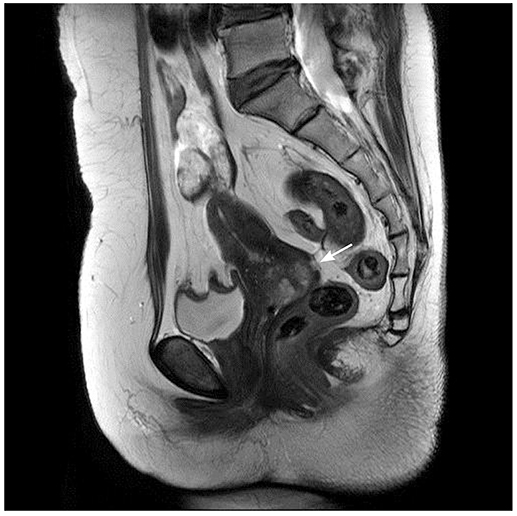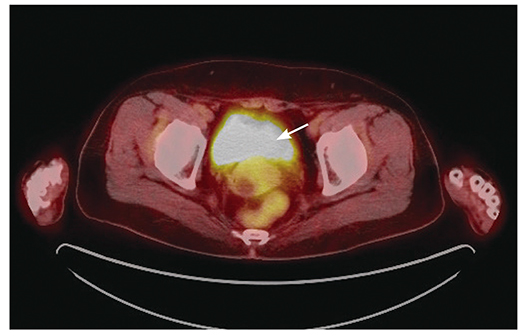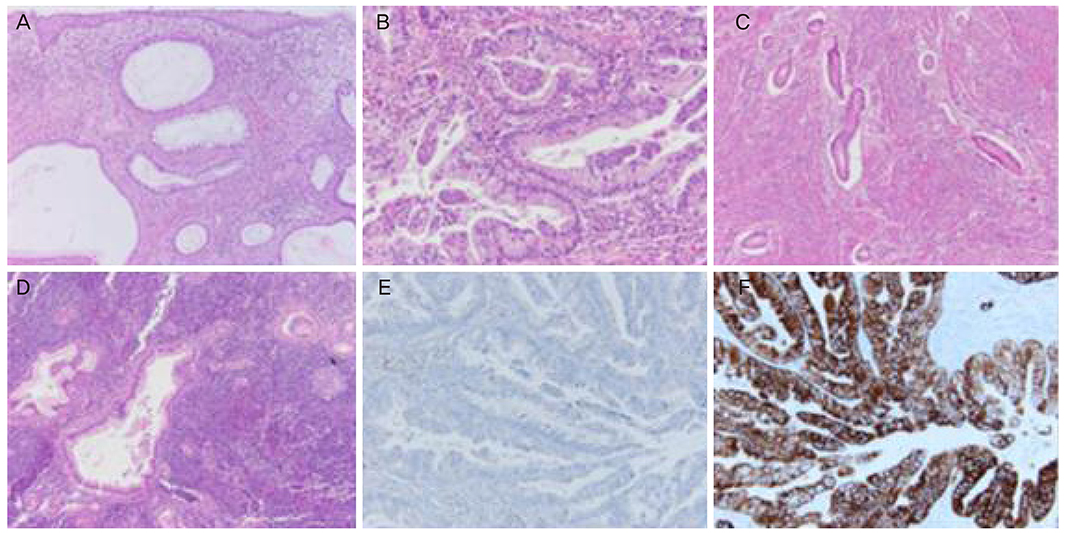Obstet Gynecol Sci.
2018 Jan;61(1):165-169. 10.5468/ogs.2018.61.1.165.
Gastric type mucinous endocervical adenocarcinoma of the uterine cervix: very rare and interesting case
- Affiliations
-
- 1Department of Obstetrics and Gynecology, Jeju National University Hospital, Jeju, Korea. obgymd@gmail.com
- 2Department of Pathology, Jeju National University Hospital, Jeju, Korea.
- KMID: 2420167
- DOI: http://doi.org/10.5468/ogs.2018.61.1.165
Abstract
- Gastric type mucinous endocervical adenocarcinomas of the uterine cervix (GAC) are a newly classified mucinous subtype with morphologically in 2014, WHO. They have a much more aggressiveness and show unusual metastatic patterns compared to usual type endocervical adenocarcinoma. They tend to present at higher stage and even in stage I, they have worse survival. Therefore, differential diagnosis of GAC from the usual type of endocervical adenocarcinoma is very important because they are related to a significant risk of recurrence and decreased 5-year disease-specific survival. Besides, GACs are mostly not associated with human papillomavirus (HPV) infection and p16 immunohistochemistry is also typically negative in GAC that is HPV-unassociated tumor. We report a very rare and interesting case of stage IB1 GAC with negative HPV DNA and p16.
Keyword
MeSH Terms
Figure
Reference
-
1. Bergström R, Sparén P, Adami HO. Trends in cancer of the cervix uteri in Sweden following cytological screening. Br J Cancer. 1999; 81:159–166.
Article2. Smith HO, Tiffany MF, Qualls CR, Key CR. The rising incidence of adenocarcinoma relative to squamous cell carcinoma of the uterine cervix in the United States--a 24-year population-based study. Gynecol Oncol. 2000; 78:97–105.
Article3. Arraiz GA, Wigle DT, Mao Y. Is cervical cancer increasing among young women in Canada? Can J Public Health. 1990; 81:396–397.4. Chilvers C, Mant D, Pike MC. Cervical adenocarcinoma and oral contraceptives. Br Med J (Clin Res Ed). 1987; 295:1446–1447.
Article5. Eide TJ. Cancer of the uterine cervix in Norway by histologic type, 1970–84. J Natl Cancer Inst. 1987; 79:199–205.6. Wilbur DC, Mikami Y, Colgan TJ, Park KJ, Ferenczy AS, Ronnett BM, et al. Glandular tumors and precursors. In : Kurman RJ, Carcangiu ML, Herrington CS, Young RH, editors. WHO classification of tumours of female reproductive organs. Lyon: International Agency for Research on Cancer;2014. p. 183–189.7. Kojima A, Mikami Y, Sudo T, Yamaguchi S, Kusanagi Y, Ito M, et al. Gastric morphology and immunophenotype predict poor outcome in mucinous adenocarcinoma of the uterine cervix. Am J Surg Pathol. 2007; 31:664–672.
Article8. Park KJ, Kiyokawa T, Soslow RA, Lamb CA, Oliva E, Zivanovic O, et al. Unusual endocervical adenocarcinomas: an immunohistochemical analysis with molecular detection of human papillomavirus. Am J Surg Pathol. 2011; 35:633–646.9. Houghton O, Jamison J, Wilson R, Carson J, McCluggage WG. p16 Immunoreactivity in unusual types of cervical adenocarcinoma does not reflect human papillomavirus infection. Histopathology. 2010; 57:342–350.
Article10. Andersson S, Rylander E, Larsson B, Strand A, Silfversvärd C, Wilander E. The role of human papillomavirus in cervical adenocarcinoma carcinogenesis. Eur J Cancer. 2001; 37:246–250.
Article11. Quint KD, de Koning MN, Geraets DT, Quint WG, Pirog EC. Comprehensive analysis of Human Papillomavirus and Chlamydia trachomatis in in-situ and invasive cervical adenocarcinoma. Gynecol Oncol. 2009; 114:390–394.12. Chou YY, Lin MC, Huang LW. Human papillomavirus-unrelated gastric type of cervical adenocarcinoma presenting with a metastatic ovarian tumor: report of a case. J Low Genit Tract Dis. 2013; 17:218–222.13. Karamurzin YS, Kiyokawa T, Parkash V, Jotwani AR, Patel P, Pike MC, et al. Gastric-type endocervical adenocarcinoma: an aggressive tumor with unusual metastatic patterns and poor prognosis. Am J Surg Pathol. 2015; 39:1449–1457.
- Full Text Links
- Actions
-
Cited
- CITED
-
- Close
- Share
- Similar articles
-
- Gastric Metastasis from Gastric-Type Mucinous Adenocarcinoma of Uterine Cervix: A Case Report
- Large, Multilocular Cystic Mass in the Uterine Cervix Mimicking Adenoma Malignum
- Ovarian Mucinous Adenocarcinoma Associated with Mucinous Adenocarcinoma of the Uterine Cervix
- A case of mucinous adenocarcinoma of the renal pelvis
- Minimal Deviation Adenocarcinoma, Mucinous Type, of the Uterine Cervix: Report of a Case with Extensive Metastasis to the Uterine Corpus and Bilateral Adnexae




